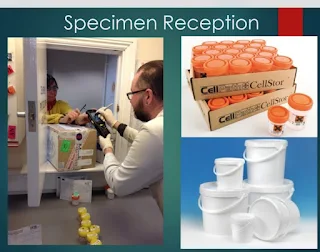Histopathology in Practice BMLT
- Sample Reception,
- Sample records
- Labelling of histology
Histology
- The science concerned with the microscopic structure of tissues and organs in relation to their function.
Also called microanatomy
Specimen Reception
 |
Specimen Unpacking
Specimen QC
Specimen Labelling
Sample Documenting
Cassetting
Specimen Dissection the stage
Dissecting props
- Cutting board
- Forceps
- Ruler
- Scalpel / knives / saw
- Inks / dyes
- Cassettes / lids
- Biopsy pads / tissue
- Filter bags
- Weighing scales
Cut-up dictation
- Morphology” computer system
- “Dragon” dictation system
- Hands-free
- Just scan the barcode and away we go!!
Specimen Categories
A. Specimens only requiring transfer from container to tissue cassette.
B. Specimens requiring transfer but with standard sampling, counting, weighing or slicing.
C. Simple dissection required with sampling needing a low level of diagnostic assessment and/or preparation.
D. Dissection and sampling required needing a moderate level of assessment.
E. Specimens requiring complex dissection and sampling methods
Category A Specimens
Category B Specimens
Catagory C Specimens
Category D Specimens
Category E Specimens
Specimen Sampling
- Literally, taking a sample of the tissue
- Representative
- Generally, fewer blocks required if the tissue looks uniform throughout (for benign cases)
- Sampling “rules”
Specimen Storage
- Ventilated storage units
- Largest buckets lower shelves
- Units are in date (week) order
- 5-weeks’ worth of storage
- Only authorised specimens are discarded after 5 weeks
- Any outstanding cases are stored separately until further notice





















0 Comments
Thanks to Come on Comment section